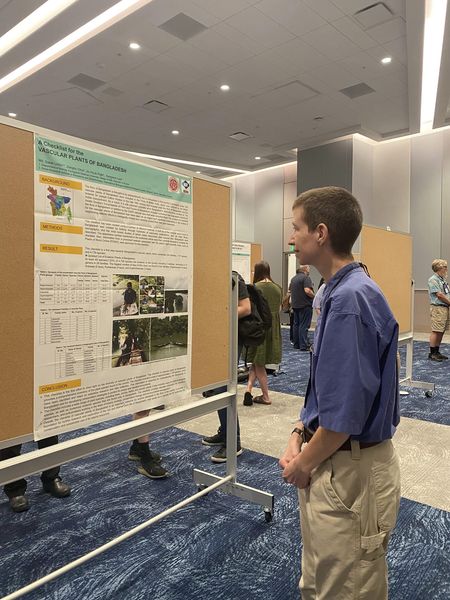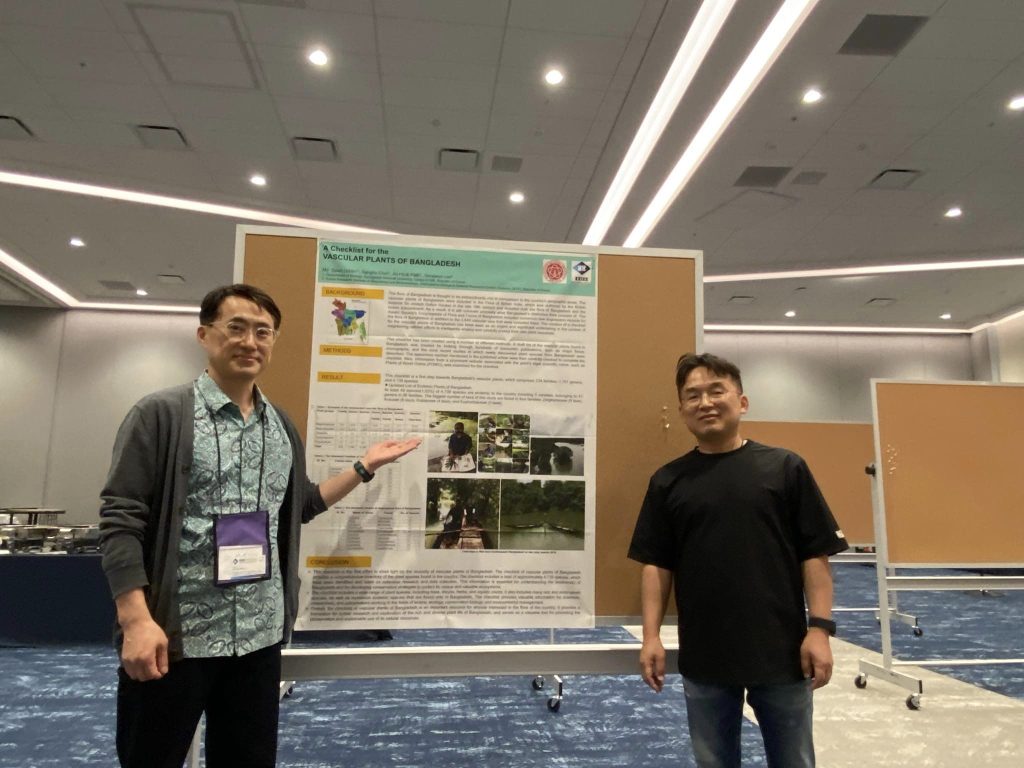In an inspiring collaboration transcending geographical boundaries, the Korea Research Institute of Bioscience and Biotechnology (KRIBB) and Kyungpook National University (KNU) teamed up to present a poster titled “A Checklist for the Vascular Plants of Bangladesh” at a distinguished university in the United States. This article highlights the fruitful partnership between these renowned Korean institutions and delves into the significance of their poster presentation on Bangladesh’s vascular plant diversity.

KRIBB and KNU, both esteemed institutions in South Korea, joined forces to tackle the ambitious task of compiling a comprehensive checklist of the vascular plants found in Bangladesh. Combining their botanical expertise and research capabilities, the collaboration sought to contribute to the understanding and conservation of Bangladesh’s unique flora.

Poster Presentation Overview: The poster presentation showcased the meticulous work conducted by KRIBB and KNU in creating a comprehensive checklist of the vascular plants of Bangladesh. The researchers aimed to present a valuable resource for scientists, conservationists, and policymakers engaged in biodiversity conservation, ecological research, and botanical studies.
Objectives of the Poster Presentation: The primary objectives of the poster presentation were as follows:
- Compilation of Comprehensive Checklist: KRIBB and KNU aimed to present an all-encompassing checklist of vascular plants in Bangladesh. The checklist provided a consolidated reference for researchers, enabling them to study and explore the rich botanical heritage of the country.
- Sharing Knowledge: The poster presentation facilitated the dissemination of valuable botanical knowledge beyond borders. By sharing their research with an international audience, KRIBB and KNU sought to foster cross-cultural learning, promote collaboration, and encourage global scientific engagement.
- Encouraging Conservation Efforts: By highlighting the diversity and importance of Bangladesh’s vascular plants, the poster presentation aimed to raise awareness about conservation efforts. The checklist served as a foundation for formulating strategies to protect and preserve the country’s plant species.
Methodology and Research Process: The collaborative effort involved extensive field surveys conducted by the researchers across diverse ecosystems in Bangladesh. The team of botanists meticulously collected plant specimens, documenting their morphological characteristics and geographical distribution. These specimens were carefully analyzed, identified, and cross-referenced with existing botanical literature, herbarium collections, and taxonomic databases.
The researchers employed taxonomic tools and techniques to classify and categorize the collected plant specimens accurately. They recorded plant identification keys, descriptions, and distribution patterns, resulting in a comprehensive checklist that showcased the remarkable vascular plant diversity of Bangladesh.
Significance and Implications: The poster presentation by KRIBB and KNU carried immense significance and several implications:
- Conservation and Biodiversity: By providing a comprehensive checklist, the researchers contributed to the conservation and management of Bangladesh’s botanical diversity. The poster presentation emphasized the need for preserving and protecting the country’s unique flora and its associated ecosystems.
- International Collaboration: The partnership between KRIBB and KNU showcased the importance of global collaboration in advancing scientific knowledge. The poster presentation facilitated connections between researchers from different continents, fostering future collaborations and knowledge exchange.
- Scientific Advancement: The checklist served as a valuable resource for researchers, enabling further botanical studies and scientific investigations into the vascular plants of Bangladesh. It provided a foundation for ecological research, taxonomic studies, and conservation initiatives.
Conclusion: The collaborative poster presentation by KRIBB and KNU on “A Checklist for the Vascular Plants of Bangladesh” exemplifies the power of cross-continental collaborations in advancing scientific knowledge and conservation efforts. Through their meticulous research and compilation of the checklist, these Korean institutions have contributed to the understanding and preservation of Bangladesh’s botanical heritage.
The primary objective of the poster presentation was to present a comprehensive checklist of the vascular plants in Bangladesh. The researchers aimed to create a valuable resource for scientists, conservationists, and policymakers involved in biodiversity conservation and ecological studies. The checklist serves as a reference point for understanding the country’s plant diversity, aiding in future research, and assisting in the formulation of conservation strategies.
The researchers utilized an exhaustive approach in compiling the checklist. Extensive field surveys were conducted across various regions of Bangladesh, including forests, wetlands, grasslands, and cultivated areas. The team of botanists and taxonomists carefully collected plant specimens, documented their morphological characteristics, and preserved them for further examination and identification.
The collected plant specimens were later analyzed in the laboratory, employing various taxonomic tools and techniques. The team cross-referenced their findings with existing botanical literature, herbarium collections, and taxonomic databases to ensure accuracy. Plant identification keys, descriptions, and distribution patterns were incorporated into the checklist, providing a comprehensive overview of the vascular plants of Bangladesh.
Results and Significance: The poster presentation highlighted the impressive findings of the researchers. The checklist encompasses a vast array of plant families, including flowering plants, ferns, gymnosperms, and other related taxa. It serves as a valuable tool for scientists, educators, and enthusiasts interested in exploring the country’s flora.
By presenting their work at an esteemed American university, the researchers aimed to raise awareness about Bangladesh’s botanical diversity on an international platform. The poster presentation facilitated knowledge exchange and encouraged collaboration among botanists from different corners of the globe, enabling a broader understanding of plant species distribution and conservation efforts.
The poster presentation titled “A Checklist for the Vascular Plants of Bangladesh” presented by the researchers at a prestigious American university shed light on the rich botanical heritage of Bangladesh. Through their extensive fieldwork, meticulous analysis, and comprehensive documentation, the team created a valuable resource for botanists, researchers, and conservationists worldwide.
The checklist serves as a foundation for further botanical studies, promoting scientific exploration, and encouraging conservation initiatives. By sharing their work with an international audience, the researchers have fostered global collaboration and highlighted the importance of preserving the remarkable diversity of vascular plants in Bangladesh.














